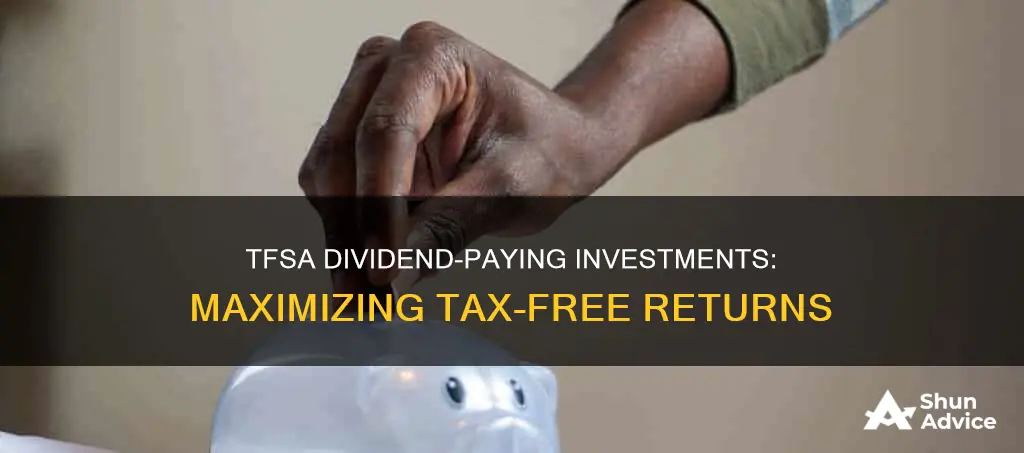
Tax-Free Savings Accounts (TFSAs) are a valuable tool for Canadians to grow their wealth while enjoying tax-free growth and withdrawals. Any interest, dividends or capital gains earned on investments in a TFSA are not taxable either while held in the account or when withdrawn. This means that dividend income earned in a TFSA does not need to be reported on your tax return. Dividends can be reinvested through Dividend Reinvestment Plans (DRIPs), allowing investors to benefit from compounding growth over time.
While TFSAs offer significant advantages, there are some tax issues to be aware of when holding dividend stocks in the account. For example, dividends from foreign stocks may be subject to withholding taxes by foreign governments, which can reduce overall dividend income. Additionally, if your TFSA is determined to be used for carrying on a business, all gains could be taxed as business income.
| Characteristics | Values |
|---|---|
| Dividends in TFSA | Tax-free |
| Taxation of Dividends in TFSA | Do not have to report dividend income on tax return |
| Dividend Types | Eligible and Non-Eligible |
| Eligible Dividends | Paid by Canadian corporations |
| Non-Eligible Dividends | Paid by foreign corporations or Canadian private corporations |
| Maximizing Dividend Returns in TFSA | Reinvesting Dividends, Asset Allocation, Focus on "Dividend Aristocrats" |
| TFSA Contribution Limits | Annual: $6,000, Lifetime: $75,500 (as of 2023) |
| Non-Canadian Dividends | Subject to withholding taxes |
What You'll Learn

Dividends from foreign stocks are taxed
Dividends from foreign stocks are indeed taxed, and the process can be complex. When investing in foreign companies, your dividends may be taxed twice: first by the country in which the company is based, and then again in your home country. The rate at which you are taxed depends on the specific countries involved.
To avoid this double taxation, many countries have tax treaties in place. For example, the US offers a "foreign tax credit" to offset taxes paid to foreign governments, thereby reducing US tax liability. This credit is non-refundable, meaning that if the credit is larger than your US tax liability, you will not receive a refund for the difference.
It is important to note that tax treaties and the amount of tax you can claim as a credit depend on the specifics of each treaty and the countries involved. Therefore, it is recommended to research local tax rates before investing in foreign companies. Consulting a financial advisor or accountant can also help you navigate the complexities of foreign dividend taxation.
Retirement Account: Investing Beyond $5500
You may want to see also

Dividend Reinvestment Plans (DRIPs)
DRIPs allow investors to buy more shares in the company that paid the dividend, and this is done automatically on the dividend payment date. This strategy allows investors to compound their returns over time by accumulating more shares, which themselves pay dividends that will be reinvested.
DRIPs are beneficial to investors as they allow them to receive any growth from the stock as well as gains from compounding. The advantages of DRIPs include:
- Accumulating more shares without paying a commission
- Shares are often offered at a discount
- Investors can buy fractional shares
- Long-term gains from automatic reinvestment and compounding
There are some disadvantages to DRIPs, including:
- Inflexible reinvestment schedules
- DRIPs only invest in their own stock
- Minimum share requirements to participate in the plan
- Taxes on dividends must still be paid
Investments: Vanguard's Guide to Choosing Wisely
You may want to see also

Asset allocation and diversification
- Asset Allocation: This refers to the percentage of stocks, bonds, and cash in your portfolio. It is the main determinant of your investment risk. For example, a 100% stock allocation is the riskiest, while a 100% cash allocation is the least risky. The appropriate asset allocation depends on factors such as your age, goals, and risk tolerance.
- Diversification: This involves spreading your assets across various asset classes within the three buckets of stocks, bonds, and cash. Diversification helps to further reduce investment risk. It is important to diversify not only across different asset classes but also globally, as 75% of the world's GDP is generated outside the US.
When deciding on an asset allocation strategy, it is crucial to consider your time horizon and risk tolerance. Your time horizon refers to the expected period you will be investing to achieve a financial goal. If you have a longer time horizon, you may be more comfortable taking on riskier investments. On the other hand, if you have a shorter time horizon, such as saving for a teenager's college education, you would likely opt for less risky investments.
Risk tolerance refers to your ability and willingness to lose some or all of your original investment in exchange for potential higher returns. An aggressive investor with a high-risk tolerance is more likely to take on riskier investments, while a conservative investor tends to favour preserving their original investment.
It is important to remember that risk and reward are intertwined. All investments carry some degree of risk, and by taking on more risk, you increase the potential for higher investment returns. Stocks, for example, have historically had the greatest risk and highest returns among the three major asset categories. In contrast, cash and cash equivalents offer the lowest returns but are the safest investments.
By combining asset allocation and diversification strategies, you can create a well-balanced portfolio that aligns with your financial goals and risk tolerance. For example, a portfolio with a 60% stock, 30% bond, and 10% cash allocation can be diversified by investing in various sectors and regions, such as consumer cyclicals, energy, financials, small caps, foreign stocks, and emerging markets.
Remember, effective asset allocation and diversification will not keep pace with the best-performing asset class each year, but they will help cushion the impact of the worst-performing asset class. These strategies are designed to smooth out market volatility and provide competitive returns while minimising overall market risk.
Who Invests in Precious Metals?
You may want to see also

Dividend aristocrats
To be a Dividend Aristocrat, a company must meet certain minimum size and liquidity requirements. These companies have historically outperformed the S&P 500 as a whole, and they have exhibited lower risk than the benchmark, as measured by standard deviation.
Some examples of Dividend Aristocrats include:
- Johnson & Johnson
- 3M
- Coca-Cola
- Sysco Corporation
- Target Corporation
- Medtronic
- PPG Industries
Russia: Invest or Avoid?
You may want to see also

TFSA contribution limits
It is important to note that individuals must be at least 18 years old and have a valid social insurance number (SIN) to contribute to a TFSA. The contribution room accumulates every year, even if an individual does not contribute the maximum amount. However, if contributions exceed the available room, a tax of 1% per month is charged on the excess amount. This tax is calculated based on the highest excess amount in each month and must be paid by June 30th of the following year.
Individuals can check their TFSA contribution room through the CRA's online services or by contacting the CRA directly. It is important to keep records of TFSA transactions to ensure that contributions do not exceed the available room.
Investments: How Much is Too Much?
You may want to see also
Frequently asked questions
TFSA dividend-paying investments are a way to grow your wealth in a tax-efficient manner. Dividends are a portion of a company's profits distributed to shareholders. By investing in dividend-paying stocks through your TFSA, you can benefit from tax-free dividend income and capital gains.
TFSA dividend-paying investments offer several advantages. Firstly, any dividends earned within the TFSA are tax-free, and you don't need to report them on your tax return. Secondly, they provide diversification to your investment portfolio, reducing risk and potentially increasing overall returns. Additionally, reinvesting dividends through Dividend Reinvestment Plans (DRIPs) can lead to compounding growth over time.
While TFSA dividend-paying investments offer tax advantages, there are a few considerations to keep in mind. Firstly, be mindful of TFSA contribution limits to avoid over-contribution penalties. Secondly, foreign dividend-paying stocks within a TFSA may be subject to withholding taxes by foreign governments, which can reduce your overall dividend income. Lastly, Canadian dividend stocks held within a TFSA are not eligible for the dividend tax credit, as the dividends are already tax-free.
To get started with TFSA dividend-paying investments, consider the following:
- Consult a qualified financial professional to tailor your investment approach to your specific goals and risk tolerance.
- Focus on well-established companies with a history of consistently increasing their dividend payments, often referred to as "dividend aristocrats."
- Diversify your TFSA holdings across various dividend-paying companies, sectors, or geographic regions to spread risk.
- Consider enrolling in Dividend Reinvestment Plans (DRIPs) offered by dividend-paying companies to automatically reinvest dividends and benefit from compounding growth.







